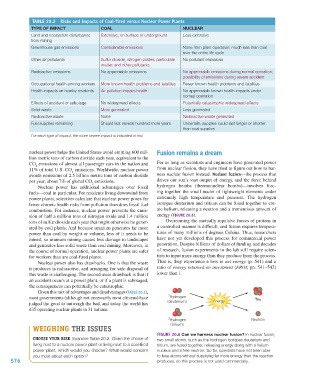Page 577 - Environment: The Science Behind the Stories
P. 577
TABLE 20.2 Risks and Impacts of Coal-fired versus Nuclear Power Plants
TYPE OF IMPACT COAL NUCLEAR
Land and ecosystem disturbance Extensive, on surface or underground Less extensive
from mining
Greenhouse gas emissions Considerable emissions None from plant operation; much less than coal
over the entire life cycle
Other air pollutants Sulfur dioxide, nitrogen oxides, particulate No pollutant emissions
matter, and other pollutants
Radioactive emissions No appreciable emissions No appreciable emissions during normal operation;
possibility of emissions during severe accident
Occupational health among workers More known health problems and fatalities Fewer known health problems and fatalities
Health impacts on nearby residents Air pollution impairs health No appreciable known health impacts under
normal operation
Effects of accident or sabotage No widespread effects Potentially catastrophic widespread effects
Solid waste More generated Less generated
Radioactive waste None Radioactive waste generated
Fuel supplies remaining Should last several hundred more years Uncertain; supplies could last longer or shorter
than coal supplies
For each type of impact, the more severe impact is indicated in red.
nuclear power helps the United States avoid emitting 600 mil- Fusion remains a dream
lion metric tons of carbon dioxide each year, equivalent to the
CO emissions of almost all passenger cars in the nation and For as long as scientists and engineers have generated power
2
11% of total U.S. CO emissions. Worldwide, nuclear power from nuclear fission, they have tried to figure out how to har-
2
avoids emissions of 2.5 billion metric tons of carbon dioxide ness nuclear fusion instead. Nuclear fusion—the process that
per year, about 7% of global CO emissions. drives our sun’s vast output of energy, and the force behind
2
Nuclear power has additional advantages over fossil hydrogen bombs (thermonuclear bombs)—involves forc-
fuels—coal in particular. For residents living downwind from ing together the small nuclei of lightweight elements under
power plants, scientists calculate that nuclear power poses far extremely high temperature and pressure. The hydrogen
fewer chronic health risks from pollution than does fossil fuel isotopes deuterium and tritium can be fused together to cre-
combustion. For instance, nuclear power prevents the emis- ate helium, releasing a neutron and a tremendous amount of
sion of half a million tons of nitrogen oxide and 1.4 million energy (FIGURE 20.6).
tons of sulfur dioxide each year that might otherwise be gener- Overcoming the mutually repulsive forces of protons in
ated by coal plants. And because uranium generates far more a controlled manner is difficult, and fusion requires tempera-
power than coal by weight or volume, less of it needs to be tures of many millions of degrees Celsius. Thus, researchers
mined, so uranium mining causes less damage to landscapes have not yet developed this process for commercial power
and generates less solid waste than coal mining. Moreover, in generation. Despite billions of dollars of funding and decades
the course of normal operation, nuclear power plants are safer of research, fusion experiments in the lab still require scien-
for workers than are coal-fired plants. tists to input more energy than they produce from the process.
Nuclear power also has drawbacks. One is that the waste That is, they experience a loss in net energy (p. 541) and a
it produces is radioactive, and arranging for safe disposal of ratio of energy returned on investment (EROI; pp. 541–542)
this waste is challenging. The second main drawback is that if lower than 1.
an accident occurs at a power plant, or if a plant is sabotaged,
the consequences can potentially be catastrophic.
Given this mix of advantages and disadvantages (TABLE 20.2),
most governments (although not necessarily most citizens) have 2 Hydrogen 4 He
judged the good to outweigh the bad, and today the world has (deuterium) Energy
435 operating nuclear plants in 31 nations.
3 Hydrogen Neutron
WEIGHING THE ISSUES (tritium)
FIGURE 20.6 Can we harness nuclear fusion? In nuclear fusion,
CHOOSE YOUR RISK Examine Table 20.2. Given the choice of two small atoms, such as the hydrogen isotopes deuterium and
living next to a nuclear power plant or living next to a coal-fired tritium, are fused together, releasing energy along with a helium
power plant, which would you choose? What would concern nucleus and a free neutron. So far, scientists have not been able
you most about each option? to fuse atoms without supplying far more energy than the reaction
576 produces, so this process is not used commercially.
M20_WITH7428_05_SE_C20.indd 576 13/12/14 1:56 PM

